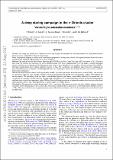A deep staring campaign in the σ Orionis cluster. Variability in substellar members
Abstract
Context. The young star cluster near σ Orionis is one of the primary environments to study the properties of young brown dwarfs down to masses comparable to those of giant planets. Aims. Deep optical imaging is used to study time-domain properties of young brown dwarfs in sigma Orionis over typical rotational time-scales and to search for new substellar and planetary-mass cluster members. Methods. We used VIMOS at the VLT to monitor a 24′x 16′ field in the I-band.Using the individual images from this run we investigated the photometric time series of nine substellar cluster members with masses from 10 to 60 Mjup. The deep stacked image shows cluster members down to ≈ 5 Mjup. We search for new planetary mass objects by combining our deep I-band photometry with public J-band magnitudes and by examining the nearby environment of known very low mass members for possible companions. Results. We find two brown dwarfs, with significantly variable, a periodic light curves, both with masses around 50 Mjup, one of which was previously unknown to be variable. The physical mechanism responsible for the observed variability is likely different for the two objects. The variability of the first object, a single-lined spectroscopic binary, is most likely linked to its accretion disc, the second may be caused by variable extinction by large grains. We find five new candidate members from the colour-magnitude diagram and three from a search for companions within 2000 au. We rule all eight sources out as potential members based on non-stellar shape and/or infrared colours. The I-band photometry is made available as a public dataset. We present two variable brown dwarfs. One is consistent with ongoing accretion, the other, exhibiting apparent transient variability without presence of an accretion disc. Our analysis confirms the existing census of substellar cluster members down to ≈ 7 Mjup. The zero result from our companion search agrees with the low occurrence rate of wide companions to brown dwarfs found in other works.
Citation
Elliott , P , Scholz , A , Jayawardhana , R , Eislöffel , J & Hébrard , E M 2017 , ' A deep staring campaign in the σ Orionis cluster. Variability in substellar members ' , Astronomy & Astrophysics , vol. 608 , A66 . https://doi.org/10.1051/0004-6361/201730973
Publication
Astronomy & Astrophysics
Status
Peer reviewed
ISSN
0004-6361Type
Journal article
Collections
Items in the St Andrews Research Repository are protected by copyright, with all rights reserved, unless otherwise indicated.

